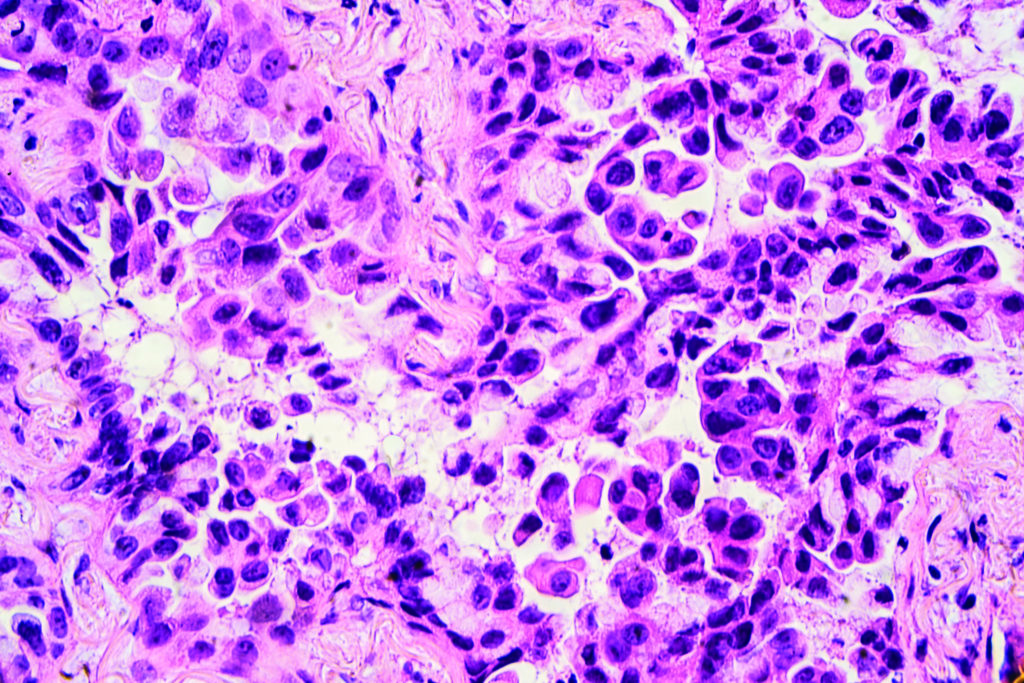What is cancer?
by Scott Dutfield · 04/02/2019

The first step to finding a cure is understanding exactly what we’re up against
You’re made up of an estimated 37.2 trillion cells, each containing an entire copy of your DNA, which consists of 23 pairs of chromosomes and 21,000 genes, written in combinations of four chemical ‘letters’: A, C, G and T. The full human DNA sequence contains around 3 billion letters, and the genes are arranged into three-letter ‘words’ called codons. Each word corresponds to a molecular building block called an amino acid and, when genes are read in order, the words in a gene provide the recipe to build a protein. Proteins are crucial for everything that a cell does, from making energy to deciding when to divide to communicating with its neighbours. But in cancer cells vital genes contain mistakes, changing their proteins and altering the way that they behave. It takes lots of genetic mistakes to turn a healthy cell into a cancer cell, and they tend to build up over time.
A few people inherit genetic faults from their parents, but most occur as we get older. Sunlight, alcohol, radiation and smoking, for example, can all cause harm to our genetic code. But even people with the healthiest lifestyles accumulate genetic faults. Cells divide for growth and repair, making copies of themselves to replace old cells or to heal wounds. In order to do this, a cell must first duplicate all 3 billion letters of its DNA, and doing this without making a single mistake is a virtually impossible task. The copied code is scanned for errors, and mistakes are usually fixed before the cell divides, but sometimes errors slip through and over time they start to build up. Just as changing the letters in a book would make the words unreadable, changing the letters in the genetic code makes it hard for the cell to make sense of its genes. If letters are changed, deleted, added or moved around, it can completely change the meaning of the genetic words, which in turn changes the proteins that the cell makes. Built-in safety mechanisms normally tell a cell to self-destruct if it has too many genetic errors, allowing a new, healthy cell to take its place. But sometimes damaged cells slip through the net, failing to repair themselves and resisting the signals to die. Cancer cells tend to have errors in genes known as ‘oncogenes’ or ‘tumour suppressor genes’.
Oncogenes are normally responsible for telling healthy cells to divide, helping with growth and wound repair, but mutations in cancer can cause them to become permanently switched on. Tumour suppressor genes, on the other hand, tell cells to stop dividing once growth or repair is completed, and errors in these genes can cause them to turn off. The result is that the damaged cells divide and divide and divide, piling up on top of each other to form a tumour. With their safety systems switched off and nothing to tell them to stop, cancer cells keep mistakes in their genetic code, and this leads to Darwinian evolution at a rapid speed. Just as if a wild animal has a beneficial genetic trait it will be more likely to reproduce, if a cancer cell has a beneficial trait it will be more likely to survive. Cancer cells forget what they are supposed to be doing and gain new abilities, developing traits that allow them to hide from the immune system, survive on less oxygen, and even evade chemotherapy. But, most dangerous of all, they gain the ability to move through the body, spreading to distant places via the blood or lymphatic systems and making new tumours elsewhere. But the more we understand about how cancer works, the better we are becoming at treating it.
The hallmarks of cancer
Scientists Douglas Hanahan and Robert Weinberg defined ten distinctive features of cancer cells
1. They change their metabolism
Cancer cells reprogram their metabolism to keep dividing under conditions that would normally kill other cells.
2. They mutate
Cancer cells accumulate more and more mutations as they continue to divide.
3. They spread
Cancer cells can spread around the body, creating more tumours in other places.
4. They are immortal
Normal cells stop dividing when they become old, but cancer cells keep on replicating indefinitely.
5. They avoid white blood cells
Cancer cells hide from the immune system, preventing the body’s natural defences from killing them.
6. They resist death
Healthy cells self-destruct when they are damaged, but cancer cells turn this safety switch off.
7. They set up fuel lines
As tumours grow, they get more oxygen and nutrients by encouraging new blood vessels to form.
8. They create inflammation
Cancer cells hijack immune cells, using inflammation that would normally help to fight against an infection to their own advantage.
9. They keep growing
Cells normally wait for a signal to divide, but cancer cells make their own growth signals.
10. They don’t stop when told
Cancer cells ignore signals telling them to stop dividing.
This article was originally published in How It Works issue 103, written by Laura Mears
For more science and technology articles, pick up the latest copy of How It Works from all good retailers or from our website now. If you have a tablet or smartphone, you can also download the digital version onto your iOS or Android device. To make sure you never miss an issue of How It Works magazine, subscribe today!





